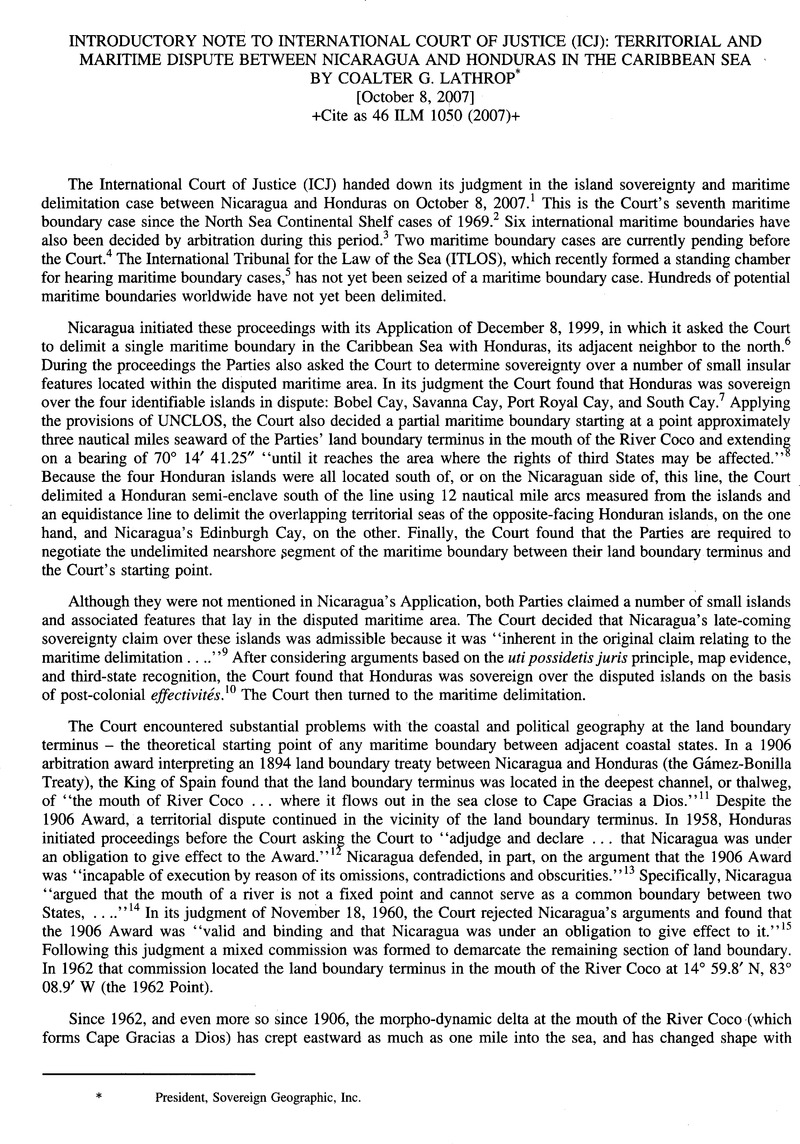Article contents
International Court of Justice (ICJ): Territorial and Maritime Dispute Between Nicaragua and Honduras in the Caribbean Sea
Published online by Cambridge University Press: 27 February 2017
Abstract

- Type
- International Legal Materials
- Information
- Copyright
- Copyright © American Society of International Law 2007
References
Endnotes
1 See Territorial and Maritime Dispute between Nicaragua and Honduras in the Caribbean Sea (Nicar. v. Hond.), 2007 I.C.J. (Oct. 8) [hereinafter Judgment]. The basic documents, decisions, written pleadings, hearing transcripts, press releases, and other materials of the Court for this case and other cases are available online at <http://www.icj-cij.org>.
2 See Continental Shelf (Tunis./Libya), 1982 I.C.J. 18 (Feb. - 24); Delimitation of the Maritime Boundary in the Gulf of Maine Area (Can./U.S.), 1984 I.C.J. 246 (Jan. 20); Continental Shelf (Libya/Malta), 1985 I.C.J. 13 (June 3); Maritime Delimitation in the Area between Greenland and Jan Mayen (Den. v. Nor.), 1993 I.C.J. 38 (June 14); Maritime Delimitation and Territorial Questions between Qatar and Bahrain (Qatar v. Bahr.), 2001 I.C.J. 40 (Mar. 16); Land and Maritime Boundary between Cameroon and Nigeria (Cameroon v. Nig.: Eq. Guinea intervening), 2002 I.C.J. 303, at 441 (Oct. 10).
3 See Delimitation ofthe Continental Shelf (U.K./Fr.), 18I.L.M. 397 (1979); Delimitation of the Maritime Boundary between Guinea and Guinea-Bissau (Guinea/Guinea-Bissau), 251.L.M. 251 (1986); St. Pierre et Miquelon (Can./Fr.), 311.L.M. 1149 (1992); Maritime Delimitation (Eritrea/Yemen) 401.L.M. 900 (2001) available at www.pca-cpa.org; Barbados/Trinidad and Tobago, 45 I.L.M. 798 (2006) available at <http://www.pcacpa.org;> Guyana/Suriname (2007) available at <http://www.pcacpa.org>.
4 Territorial and Maritime Dispute (Nicar. v. Colom.) initiated December 6, 2001; Maritime Delimitation in the Black Sea (Rom. v. Ukr.) initiated September 16, 2004.
5 See ITLOS Press Release No. 108 (16 Mar. 2007) available at <www.itlos.org>.
6 Nicaragua and Honduras share a land boundary that stretches across the Central American isthmus from the Caribbean Sea to the Gulf of Fonseca on their Pacific coast. With the exception of a short, partial delimitation in the Gulf, their Pacific maritime boundary is not delimited, nor was it before the Court in this case.
7 The Court's island sovereignty finding was only in respect of Bobel, Savanna, Port Royal and South Cays, however, the Court found that "[i]n addition to these four main cays, there are a number of smaller islets, cays and reefs in the same area, of which the physical status (such as whether they are completely submerged below sea level, either permanently or at high tide), and consequently their legal status (for the purposes ofthe application of Articles 6, 13 or 121 of UNCLOS) are not clear." Judgment, supra note 1, para. 136.
8 Judgment, supra note 1, para. 321. The third States in the vicinity of the eastern end of this delimitation are Jamaica and Colombia.
9 Judgment, supra note 1, para. 115.
10 The Honduran effectivites were not numerous, but included evidence that Honduras enforced its criminal and civil laws, regulated immigration, and carried out public works on the islands.
11 Arbitral Award Made by the King of Spain on 23 December 1906 (Hond. v. Nicar.), 1960 I.C.J. 192, at 202-203 (Nov.18) [hereinafter 1960 Judgment]. In his description of the boundary in the mouth of .the River Coco, the King of Spain included several geographic features such as the principal arm of the river, Hara, the island of San Pio, islets and shoals in the principal arm, and the harbour bar. See Id.
12 Judgment, supra note 1, para. 40.
13 Judgment, supra note 1, para. 40 quoting 1960 Judgment, supra note 11, p. 198.
14 1960 Judgment, supra note 11, p. 216.
15 Judgment, supra note 1, para. 46.
16 Land and Maritime Boundary between Cameroon and Nigeria (Cameroon v. Nig.: Eq. Guinea intervening), 2002 I.C.J. 303, at 441 (Oct. 10).
17 judgment, supra note 1, paras. 280, 283. examining the applicability of equidistance in the territorial sea in light of unclos article 15, the court found that this ' 'geomorphological problemq" constituted a special circumstance "in which it cannot apply the equidistance principle". judgment, supra note 1, paras. 280-81.
18 The Court and other tribunals have typically included islands in the first step of their analysis: the construction ofthe provisional equidistance line. See for example Maritime Delimitation and Territorial Questions between Qatar and Bahrain (Qatar v. Bahr.), 2001 I.C.J. 40 (Mar. 16); Maritime Delimitation (Eritrea/Yemen) 40 I.L.M. 900 (2001) available at <http://www.pca-cpa.org.>
19 On December 13,2007, the Court rejected most of Colombia's preliminary objections and found that it had ' 'jurisdiction, on the basis of Article XXXI of the Pact of Bogota, to adjudicate upon the dispute concerning sovereignty over the maritime features claimed by the Parties other than the islands of San Andres, Providencia and Santa Catalina." ICJ Press Release, No. 2007/30 (13 Dec. 2007) available at <http://www.icj-cij.org>.
20 Judgment, supra note 1, para. 319. The Court did limit the outer extent of its delimitation by stating that "in no case may the line be interpreted as extending more than 200 nautical miles from the baselines from which the breadth of the territorial sea is measured." Id.
- 1
- Cited by


